Some Observations of Geotechnical Aspects of the February 28, 2001, Nisqually Earthquake in Olympia, South Seattle, and Tacoma, Washington
Performance of Earth Structures
Earth Embankments
- - Landslide on Highway 101
- - Slide in Martin Way, Eastern Olympia Road Embankment
- - Earth Embankment, Olympia
- - Railroad Embankment North of 4th Ave., Olympia
- - Chambers Bay
Mechanically Stabilized Earth Retaining Walls
Solid Waste Landfills
Earth Embankments
Landslide on Highway 101

Location map of Highway 101 slide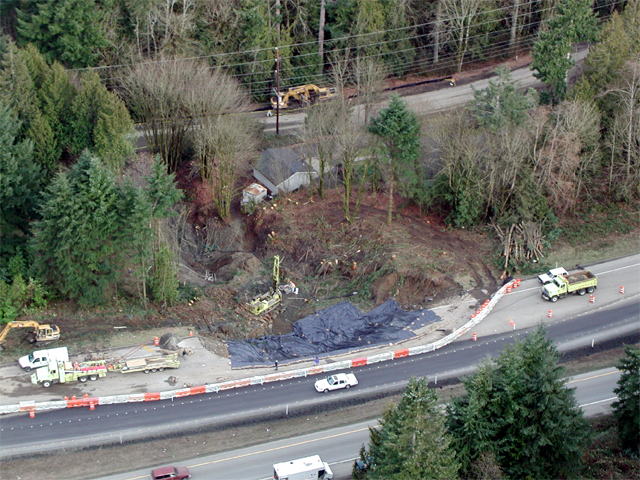
Slide in Highway 101 road embankment near State Road 8 junction.The earth embankment crosses a ravine that was carrying water at the time of the earthquake.The embankment is about 15 to 20 m high, has a crest width of 30 m, and has side slopes of approximately 1.5H:1V.A 1 m diameter corrugated metal culvert through the base of the embankment provides drainage across it. The failed material flowed downslope approximately 150 m and partially covered the road that parallels Highway 101 to the north.Pavement sections and culvert materials were foundabout 50 m and 70 m, respectively, north of the edge of the original road embankment (GPS N47.05834 W123.01365; 03/03/01).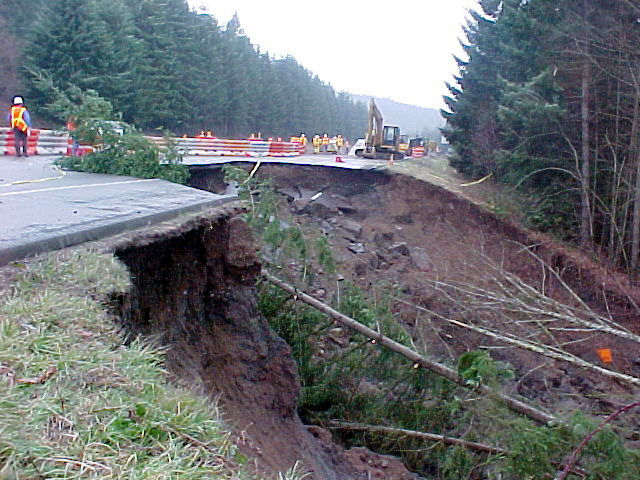
The curved headscarpof the slide is 24 m wide, and the total width of the slide at the edge of the road is 35 m.The landslide has undermined the outside lane of the two northbound lanes, so that it reaches back around 7 m from the outside edge of the emergency lane on the north shoulder of the highway (GPS N47.05834 W123.01365; 1030 03/01/01).
View of eastern end of the headscarp at the Highway 101 road embankment slide shown in the previous photograph.In this area the headscarp is approximately 6 m high (GPS N47.05834 W123.01365; 1050 03/01/01).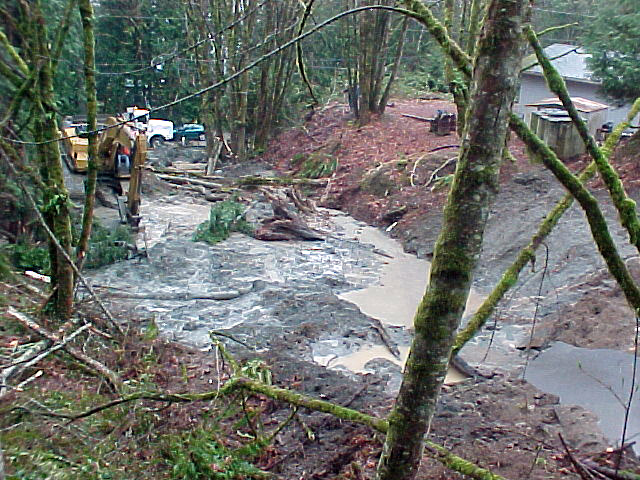
View of run-out of slide material downslope from the Highway 101 earth embankment slide. (GPS N47.05834 W123.01365; 1100 03/01/01).
Slide in Martin Way, Eastern Olympia Road Embankment
- - Download a plan view map (Mapped by Adrian Rodríguez-Marek and Jonathan D. Bray) - PDF file - 184 KB
- - Download a map with detailed crest deformations (Mapped by Adrian Rodríguez-Marek and Jonathan D. Bray) - PDF file - 266 KB
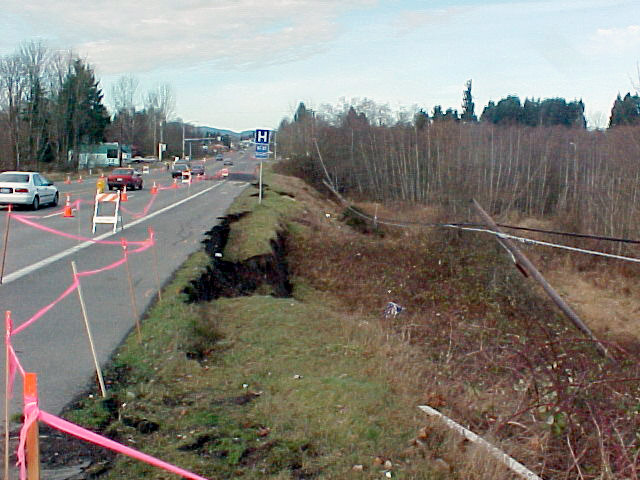
The earth embankment, which is composed of compacted uniform sand in its upper section, crosses a peat bog. The embankment is about 6.5 to 7 m high, has a crest width of 24 m, and has side slopes of approximately 1.5H:1V.The slide along the northern edge is about 120 m long, and there is a 27 m long slide along the southern edge of the embankment that reaches back 4 to 5 m from the original southern edge of the embankment (GPS N47.04693 W122.85092; 0950 03/04/01).
View to east showing slide along the northern edge of the Martin Way earth embankment slide.The maximum vertical offset of the headscarp at this area was 3.3 m (GPS N47.04693 W122.85092; 1000 03/04/01).
Earth Embankment, Olympia
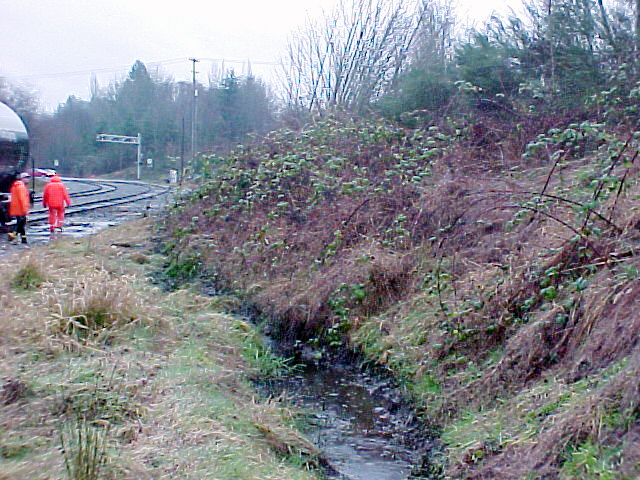
Slumping of earth embankment into ditch that parallels an active rail line between Union and Cherry Streets in Olympia.The embankment is about 5 m highThe length of the failed section of the embankment was about 50 m, although lateral displacement was observed along a total length of 120 m. The cracks in the crest of the embankment had vertical offsets of between 15 and 45 cm (GPS N47.0402 W122.8939; 1630 03/01/01).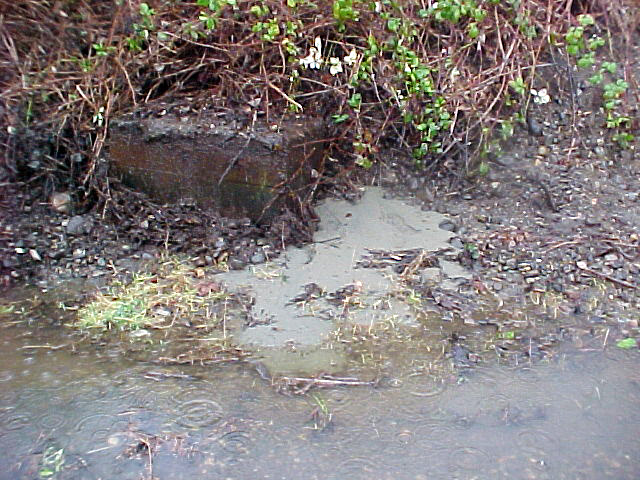
Sediment ejecta at base of embankment shown previously indicating liquefaction (GPS N47.0402 W122.8939; 1630 03/01/01)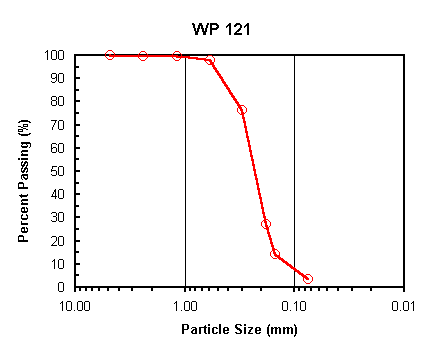
Grain size distribution of ejecta. The poorly graded clean sand classifies as an SP
(USCS, Cc = 1.7, Cu = 4.9).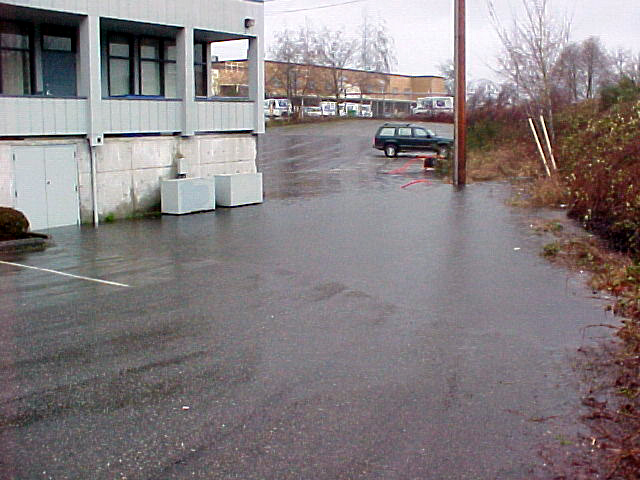
Flooding on the backside of the earth embankment shown previously due to the embankment slumping over the outlet drain and breaking the drain pipe through the embankment (GPS N47.0402 W122.8939; 1630 03/01/01)
Railroad Embankment North of 4th Ave., Olympia
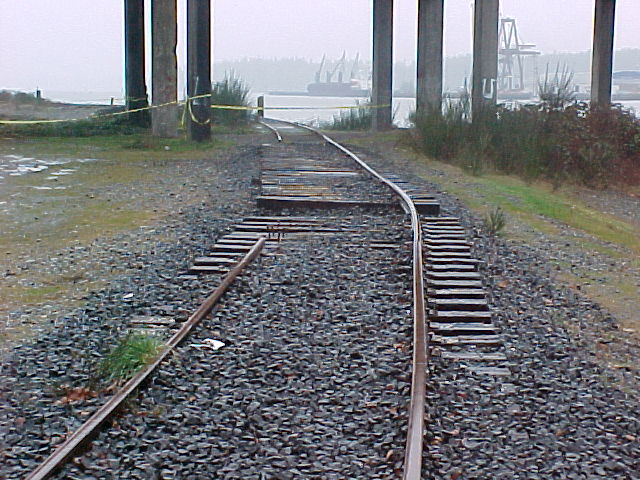
Broken rail line along the western shore of Capital Lake in Olympia (GPS N47.04401° W122.91071°; 1200 03/01/01).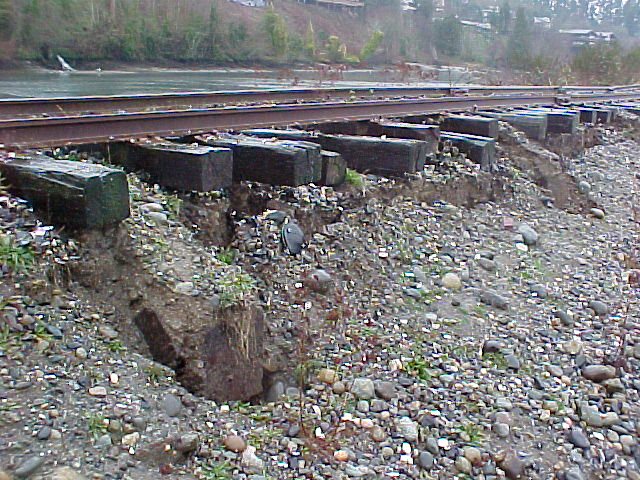
Slumping of railroad embankment in Olympia.Tracks are supported by a wooden trestle that underlies the embankment (GPS N47.04567 W122.91043; 1230 03/01/01).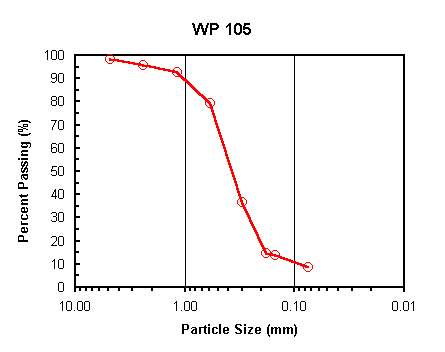
Grain size distribution of ejecta from sand boil. Sand boil was located at base of embankment on far side of tracks adjacent to the water. The poorly graded clean sand classifies as an SP (USCS, Cc = 1.1, Cu = 0.4).
Chambers Bay
Chambers Bay lies immediately to northeast from Steilacoom. Chambers Creek Road represents one of only 3 land routes into Steilacoom and is the primary route which locals travel into Tacoma. Ground failure was observed along the compacted earth embankments on both the upstream and downstream sides of the bridge. The observed cracking extended along the roadway for some distance to the south (Figure 8). Additionally, a small landslide was observed adjacent to the western edge of the upstream abutment. It is thought a sewer line that traverses the bridge broke during the earthquake and was subsequently repaired with high density polyethylene pipe (the timing of this repair work has not yet been verified). One local resident reported crossing the bridge after 21:00 on February 28, 2001, more than 10 hours after the earthquake. At that time, county officials were on scene and the bridge was closed to vehicular traffic shortly afterward. The bridge remained closed as of Sunday March 4, 2001. No evidence of liquefaction was found associated with this ground failure.
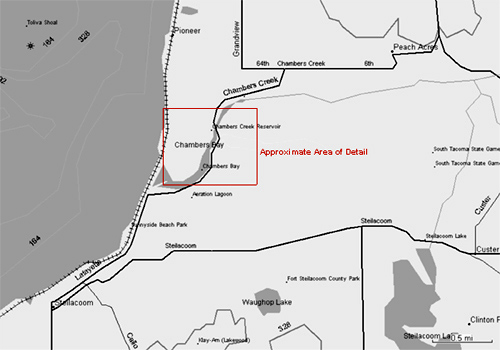
Location map of Chambers Bay
Detail view of viewed areas shown below at Chambers Bay.
Figure 11. Sewer main repair at south abutment (GPS N47.1917° W122.5733°; 0737 03/04/01)
Sewer line repair using high density polyethylene. Water distribution line (undamaged) crosses adjacent to bridge. Behind water line on far bank is small landslide with several trees within sliding block. (GPS N47.1917° W122.5733°; 0737, 03/04/01)
Ground cracking with outward movement of roadway edge and guard rail. Lateral offset is on the order of 18 cm. (GPS N47.1923° W122.5739°; 0745 03/04/01)
This small landslide is immediately west of the northern end of the water distribution pipe shown previously. This vertical head scarp is about 2 m high and parallels the edge of the roadway entrance to private property. This view, looking to the west, shows the larger of two blocks along the lower left hand side and the smaller block along the right hand side. The smaller of the two blocks is about 1 to 2 m wide about 4 m long. It translated downslope approximately 0.5 m horizontally and 0.5 m vertically. (GPS N47.1921° W122.5742°; 0754 03/04/01)
The larger of the two blocks is about 6 m wide about 6 m long. It translated downslope approximately 3 m horizontally and 2 m vertically. (GPS N47.19205° W122.57436°; 0756 03/04/01)
Mechanically Stabilized Earth (MSE) Retaining Walls
Extended Stay America at Highway 101, Tumwater

A failed MSE wall in front of the Extended Stay America in western Tumwater (lower right corner of location plan) was observed. A 2" irrigation water line was also observed near the top of the fill. However, the relative timing between the break of the water line and the failure of the wall is unknown.
Along the right hand edge of the wall, the height of the wall was 15 20-cm high blocks for a total of 3 m (GPS N47.02479 W122.92230; 02/28/01).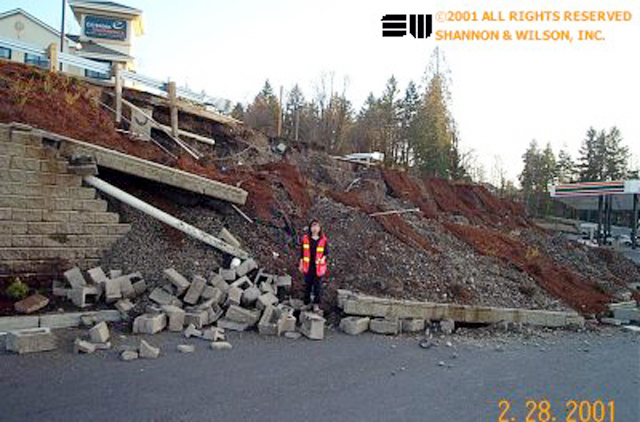
Note broken water pipe at the top of slope (GPS N47.02479 W122.92230; 02/28/01).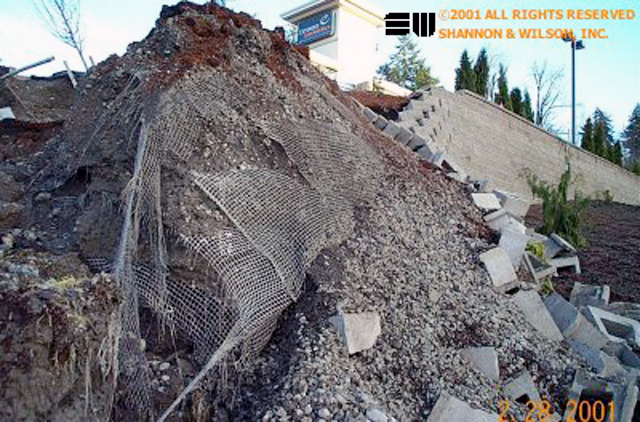
This wall had a segmental masonry facing and two types of geogrid reinforcement. The first is an asphalt-impregnated polyester biaxial geogrid with a 20 mm x 20 mm aperture. The second is a polypropylene biaxial geogrid with a 30 mm x 40 mm aperture (GPS N47.02479 W122.92230; 02/28/01).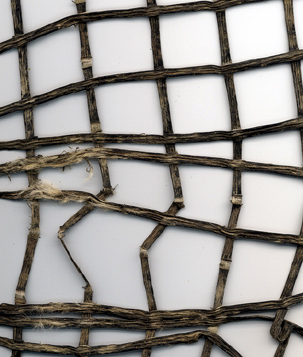
Scan of sample from 20 mm x 20 mm polyester geogrid reinforcement.
Costco MSE Wall, Tacoma

The 2:1 slope above this north-south running 5 m high MSE wall failed during the earthquake. Fill material spilled over the wall. The tarp was installed to prevent precipitation infiltration after the failure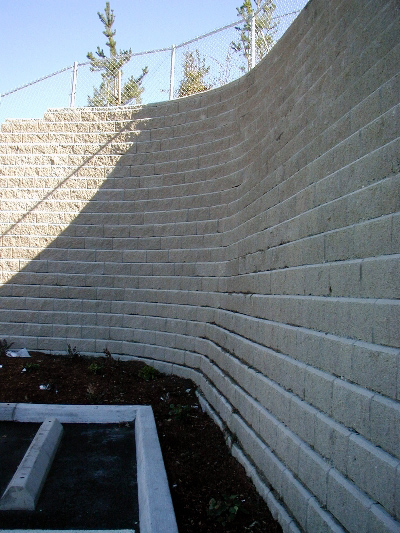
The wall itself appeared largely intact after the failure. Moisture was observed seeping through the wall, as shown here. A slight bulge was apparent in the southern half of the wall.
(N47.22452° W122.46678°; 03/05/2001)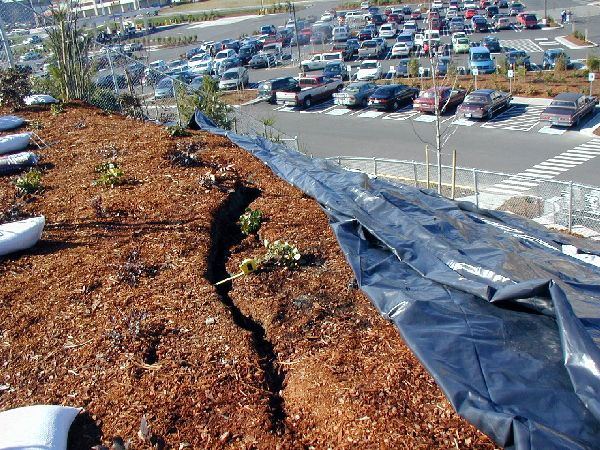
The wedge type failure produced large cracks at the crest of the embankment with horizontal offsets of up to 25 cm and vertical offsets in the range of 2-3 cm.
(N47.22483° W122.46652°; 03/02/2001)
Solid Waste Landfills
Four waste landfills in the vicinity of the earthquake were visited. These four are the Kent Landfill (closed), Midway Landfill (closed), Pierce County Landfill (a Superfund site that is partially closed but still accepting green waste), and the Lacey Landfill (open). No performance related problems were identified at any of these landfills.
Kent and Midway Landfills

Location maps of Midway and Kent Landfills.
Kent Landfill
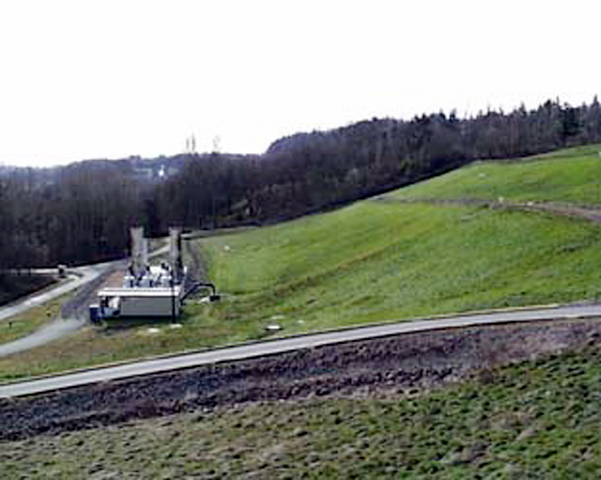
The Kent Landfill generally had fairly flat slopes. However, on the east side these slopes were on the order of 2.5H:1V. The gas extraction system was operating (GPS N47.39191 W122.27612; 1109 03/03/01).
Along the flatter slopes, high density polyethylene piping was used as gas collection piping. This view showing small movements (up to 10 cm) of the piping was typical (GPS N47.39388 W122.28138; 1051 03/03/01).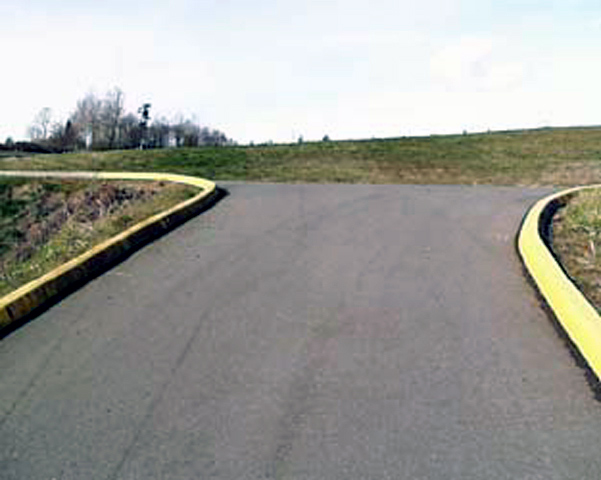
This landfill has asphaltic paving along the cover system. Except on an area at the northeast corner that is adjacent to a very steep slope, no cracking was found anywhere in the paving. The area in the northeast corner has been experiencing long-term deformations as indicated by maintenance efforts (GPS N47.39203 W122.27921; 1103, 03/03/01).
Midway Landfill
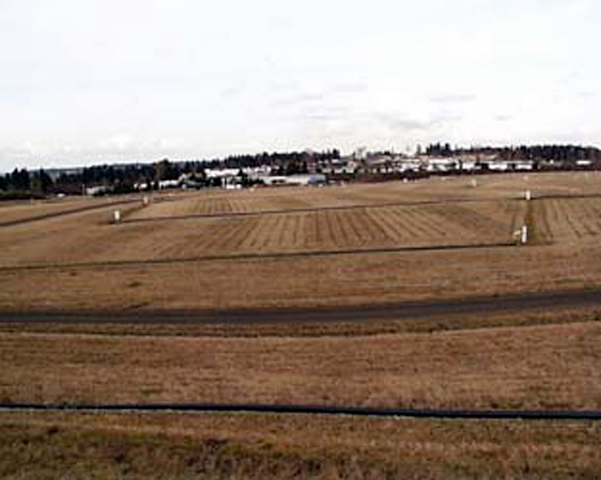
The Midway Landfill also has fairly flat slopes except on the north end (not shown). North-end slopes are on the order of 2H:1V (GPS N47.37583 W122.29367; 1157 03/03/01).
Along the north end, a boulder rested against the HDPE gas collection pipe (GPS N47.38043 W122.29422; 1215 03/03/01).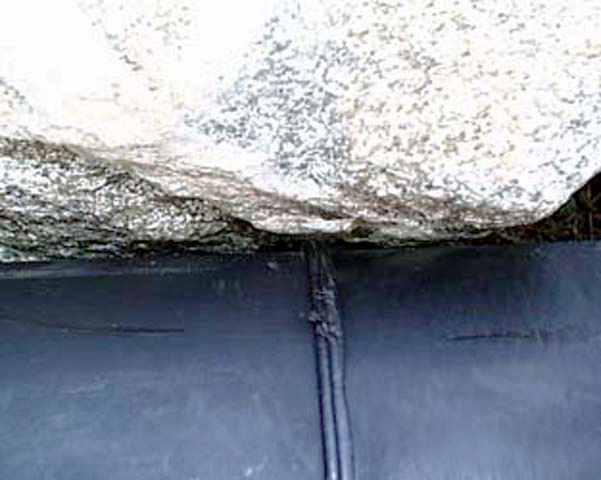
The rock was resting directly at a welded connection. Black marks are visible on the rock indicating relative movement between the rock and the HDPE piping. The rock was momentarily pulled back and the black marks measured. The relative movement was 2.5 cm each way from the point of contact (total movement of 5 cm) (GPS N47.38043 W122.29422; 1216 03/03/01).

